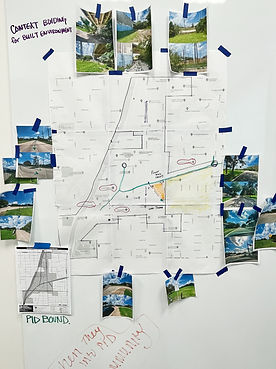
This project provided the University Crossing Public Improvement District with evidence from community engagement to guide the redesign of an unused lot. Student design teams conducted observations, canvassing, surveys, and interviews with stakeholders and experts to develop and refine prototype concepts for the space. These efforts culminated in a final prototype that helped shape design principles and recommendations for future improvements.
The Problem.
The design challenge primarily focused on understanding how we might address a vacant, city-owned piece of land, commonly referred to as The Matilda Lot, that was only being used as a de facto dog park. We had to find out who were the users, the current usage of the space, and create strategic design principals that would anchor our client moving forward.

"How Might We Improve the Quality of Life through Reimagining Land Use for the University Crossing Community?"
Harrison Tassopoulos I Emma Geoff I Tanner Williams I Kenedy Kundysek | Steve Kinder | Aline Zuniga | Dubzeey Wu
The Process.
Define
Understand
Imagine
Refine
Make
Test
Tell
Define
Define


After our initial client brief, we needed to define our terms, our scope, and understanding of the project.
What is the current quality of life for the UCPID? What is the current land use of this property?
What does community mean for this specific district?
We also needed to define our boundaries and the current conditions of the land.
Understand
Understand
To learn more about the lot, who used it, and what the community might want for the future of this space, our design team conducted primary qualitative research using several different design methods.
Research Methods
Observation
15 hours
Interviews
8 experts at various levels of leadership
Brad Cheves, Southern Methodist University; Annette Eastman, CBRE ;Krista Nightengale, Better Block Foundation; Matt Omundson Glenstar Properties; Risa Renna, Mockingbird Elementary Site-Based Decision Making Committee; Courtney Shelton, Mockingbird Elementary Site-Based Decision Making Committee; Lawrence Ward, Oncor; Taber Wetz, Mockingbird Elementary Dads’ Club
Neighborhood Canvassing & Survey
2 weekends canvassing
10+ hours invested
133 homes visited
32 doorstep conversations
46 survey responses
3 email conversations

Survey postcards

Map of houses canvassed

Door to Door Interviews

Survey postcards
Experiencing University Crossing programming - Music on Mockingbird Experiencing University Crossing public art, Visiting with JM Rizzi, Visiting University Crossing businesses, Walking the University Crossing Trail
Refine
Refine
After we collected all of our data, we spent 3 days synthesizing and making meaning out what we learned. We color coded the survey based on key themes, dissected our in person engagements, executed content frequency analysis.
Research Finding Themes
Current Usage of Matilda Lot
-
Primary Users: Residents of the North Stonewall Terrace neighborhood, including dog owners, families with children, and general walkers.
-
Usage Description: The Matilda Lot is heavily utilized by specific community groups for outdoor activities.
Desired Improvements and Preservation of Usage
-
Improvement Preferences: Community members are expressing interest in enhancements to the Matilda Lot.
-
Preservation of Space: There is a strong preference for maintaining the space's open and flexible nature during any planned improvements.
Safety and Community Wellbeing
-
Safety Goals: A significant goal for the community is to enhance the feeling of safety in the University Crossing area.
-
Role of Matilda Lot: The Matilda Lot is seen as a potential contributor to improving overall community safety.
Investment and Future Development
-
Investment in Matilda Lot: There's an interest in funding enhancements to the Matilda Lot.
-
Broader Impact: Such investments are viewed as a foundation for further development along the University Crossing Trail and its amenities.
Imagine
Imagine
Through our research, we identified strong community desires for land improvements and beautification while maintaining the current open and flexible use of the space. We knew that whatever we designed should follow these basic principals:
Respect the neighborhood and residents interests
Maintain the current use of the space as a open lot
Feel inviting and improve visitors sense of safety
Elevate and enable the community to continue to use the space
Make
Make
Test
Test
&
Our prototype took the form of a Matilda Lot Community Event which gave us an opportunity to test our guiding questions. Our prototype was comprised of four parts based on on our four required design statements.
Part 1
Community Cleanup
We wanted to try a programmed community of "Friends of Matilda Lot" that instills values of safety and works to landscape and maintain the area.
Will the neighborhood's sense of ownership around this space extend to a willingness to care for it?
Part 2
Co-Design Activity
Can the community create a space that meets their needs and aligns with their interests?
What park and park-like elements are important to this community?
How can we encourage the community to have a role in the design process?
Part 3
Park-like Elements
Can a few minimally invasive items help the community feel a sense of improvement on their quality of life?
Will people’s desires for this space change when they are considering improvements while actively visiting the space?
Part 4
Edge Activation
What visual and physical elements draw people into a space like the Matilda Lot?
How can enhancing the edges of a space help define its identity?
If the space has a more well-defined identity, do people feel more welcome there?




On Saturday, November 19, 2022, we invited the University Crossing Community to our event. Where we tested the community cleanup, installed benches and planters, activated the edges with signage, crosswalk graphics, and ballast improvements, and facilitated a co-design activity.

Results.
More than 30 community members attended the event including Councilman Paul Ridley who oversees the district in which the University Crossing Public Improvement District resides.
Overall, the neighborhood is interested in low-impact improvements that maintain the integrity of the current use of the space (open and flexible) and align with the current aesthetic of the space (natural and raw).



















